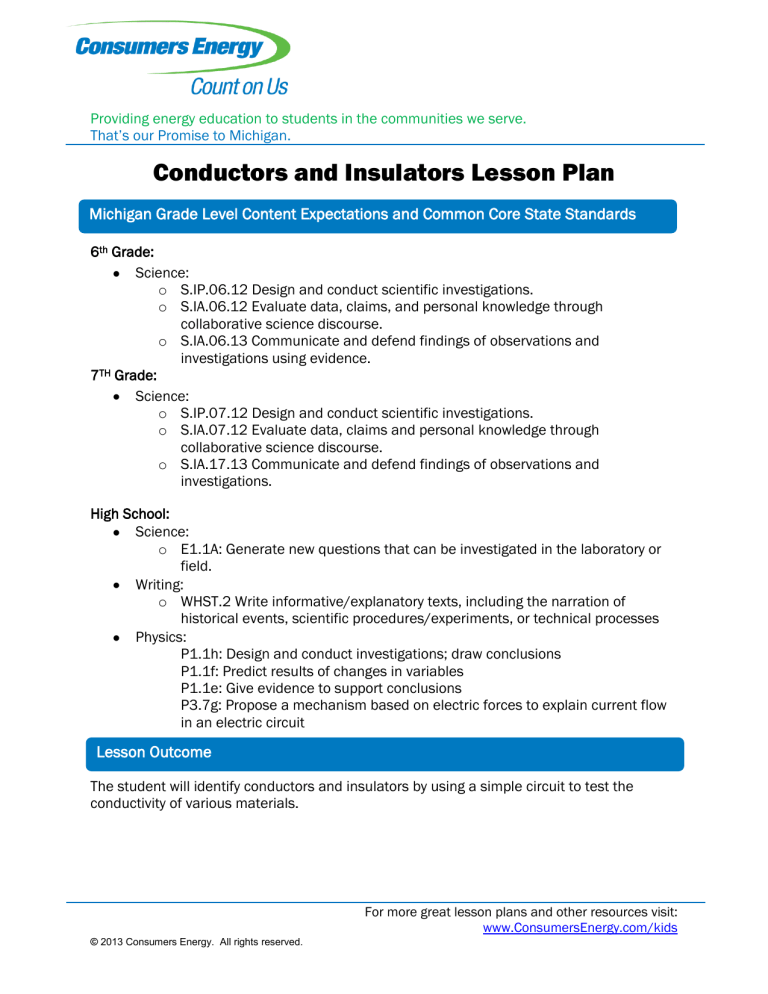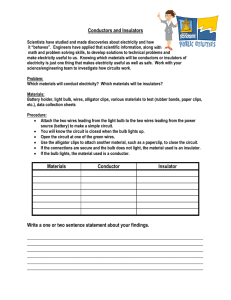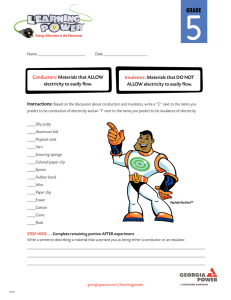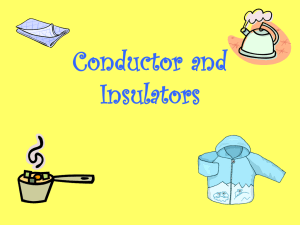Conductors and Insulators Lesson Plan

Providing energy education to students in the communities we serve.
That’s our Promise to Michigan.
Conductors and Insulators Lesson Plan
Michigan Grade Level Content Expectations and Common Core State Standards
6 th Grade:
Science: o S.IP.06.12 Design and conduct scientific investigations. o S.IA.06.12 Evaluate data, claims, and personal knowledge through collaborative science discourse.
7 TH Grade: o S.IA.06.13 Communicate and defend findings of observations and investigations using evidence.
Science: o S.IP.07.12 Design and conduct scientific investigations. o S.IA.07.12 Evaluate data, claims and personal knowledge through collaborative science discourse. o S.IA.17.13 Communicate and defend findings of observations and investigations.
High School:
Science: o E1.1A: Generate new questions that can be investigated in the laboratory or field.
Writing: o WHST.2 Write informative/explanatory texts, including the narration of historical events, scientific procedures/experiments, or technical processes
Physics:
P1.1h: Design and conduct investigations; draw conclusions
P1.1f: Predict results of changes in variables
P1.1e: Give evidence to support conclusions
P3.7g: Propose a mechanism based on electric forces to explain current flow in an electric circuit
Lesson Outcome
The student will identify conductors and insulators by using a simple circuit to test the conductivity of various materials.
For more great lesson plans and other resources visit: www.ConsumersEnergy.com/kids
© 2013 Consumers Energy. All rights reserved.
Providing energy education to students in the communities we serve.
That’s our Promise to Michigan.
Rationale / Purpose for Lesson
As a follow-up to the making a simple circuit lesson plan on our website, this activity provides an opportunity to use the circuit to understand the nature of electricity. By testing common objects, students will discover both conductors and insulators of electricity. The knowledge of conductors and insulators can be extended to discussion on the travels of electricity and electric safety. Finally, this hands-on lesson allows students to use the scientific process to hypothesize, test, and compare results.
Resources / Materials Required
Circuits made from the “ Circuits and the Flow of Electricity ” lesson plan. o
Circuit kits used to make the circuits in the lesson included the following materials: 1-D Cell battery, Battery holder, 2 - 1.5 volt bulbs, 2 sockets for the light bulbs (or E-10 light bulb bases), and 4 pieces of 6-inch insulated strand copper wire (18–22 gauge), with one inch of insulation removed at each end wire.
Materials for Circuit Kits can be purchased at a local hardware store.
2 paper fasteners or binder clips for each circuit being used.
Classroom samples of conductors and insulators (ie. Metal paper clips, metal pens, aluminum foil, coins, keys, rubber bands, erasers, glass bottles, etc.). Make sure to have enough materials for each student group to test at least 6 objects.
Copies of “Testing for Conductivity” instruction sheet (below).
Introduction
(If the “ Circuits and the Flow of Electricity ” lesson was not completed before this, set up an example of a simple circuit. Demonstrate and discuss the flow of energy.)
Have students consider the circuit. Ask, “How is the light bulb able to receive power from the battery? How does the energy move from the battery to the light bulb?” The energy moves through the metal wire, because metal is a good conductor of electricity.
Discuss the terms conductor and insulator so students understand that conductors carry electricity from one point to another and insulators stop the flow of electricity.
Have students come up with a class definition for the terms conductor and insulator and post within the classroom.
Have the students brainstorm ideas of how the circuit could be used to test materials for their conductivity.
For more great lesson plans and other resources visit: www.ConsumersEnergy.com/kids
© 2013 Consumers Energy. All rights reserved.
Providing energy education to students in the communities we serve.
That’s our Promise to Michigan.
Procedures
Select one conductor and one insulator from the classroom samples (such as a key and a rubber band as shown in the pictures.) Following procedures in Step 4 of the “Test for
Conductivity” sheet, show how the circuit can be used to test for conductivity.
Demonstrate what happens to the light bulb when both the conductor and insulator become a part of the circuit.
Conductor Insulator
Have groups of 3 or 4 students select at least 6 objects from the collection of classroom samples.
Distribute the “Testing for Conductivity” worksheet to each group and have students follow the testing instructions.
Closure
Have students discuss and compare their observations with other student groups.
Have each group write a definition for “conductor” and “insulator.” o Remind students how energy is carried when electrons move from one place to another. Discuss what conductors and insulators must do to the electrons of atoms in order to either carry or stop of the flow of electricity.
Extensions
Discuss the importance or use of conductors and insulators in daily life.
Write a letter from the point of view as a conductor or insulator (ex. “A day in the life of a conductor.”)
© 2013 Consumers Energy. All rights reserved.
For more great lesson plans and other resources visit: www.ConsumersEnergy.com/kids
Providing energy education to students in the communities we serve.
That’s our Promise to Michigan.
Name: ___________________________ Date: _________________
Testing for Conductivity
What will make the light bulb light up?
Directions
1.
Select 6 objects from the gathered “Classroom Samples”
2.
On the chart below, write the names of each object.
3.
Predict whether the object is a conductor or insulator. Record your predictions.
4.
Use your simple circuit to construct a conductivity tester. a.
Your simple circuit should have two pieces of wire – one end of each piece of wire should be attached to the battery, the other end of each piece of wire should be attached to the light bulb. b.
Remove the wire from the bottom of the battery; leave it connected to the light bulb. Wrap a paper fastener around the loose end of this wire. c.
Attach a third piece of wire to the bottom of the battery. Wrap a paper fastener around the loose end of this wire.
5.
Test your objects. One at a time, place each object between the paper fasteners, making sure they touch and have a good connection.
6.
What happens to the light bulb when each object is introduced to the circuit? Record your observations for each object.
Predictions and Observations
OBJECT NAME PREDICTION RESULTS
For more great lesson plans and other resources visit: www.ConsumersEnergy.com/kids
© 2013 Consumers Energy. All rights reserved.





